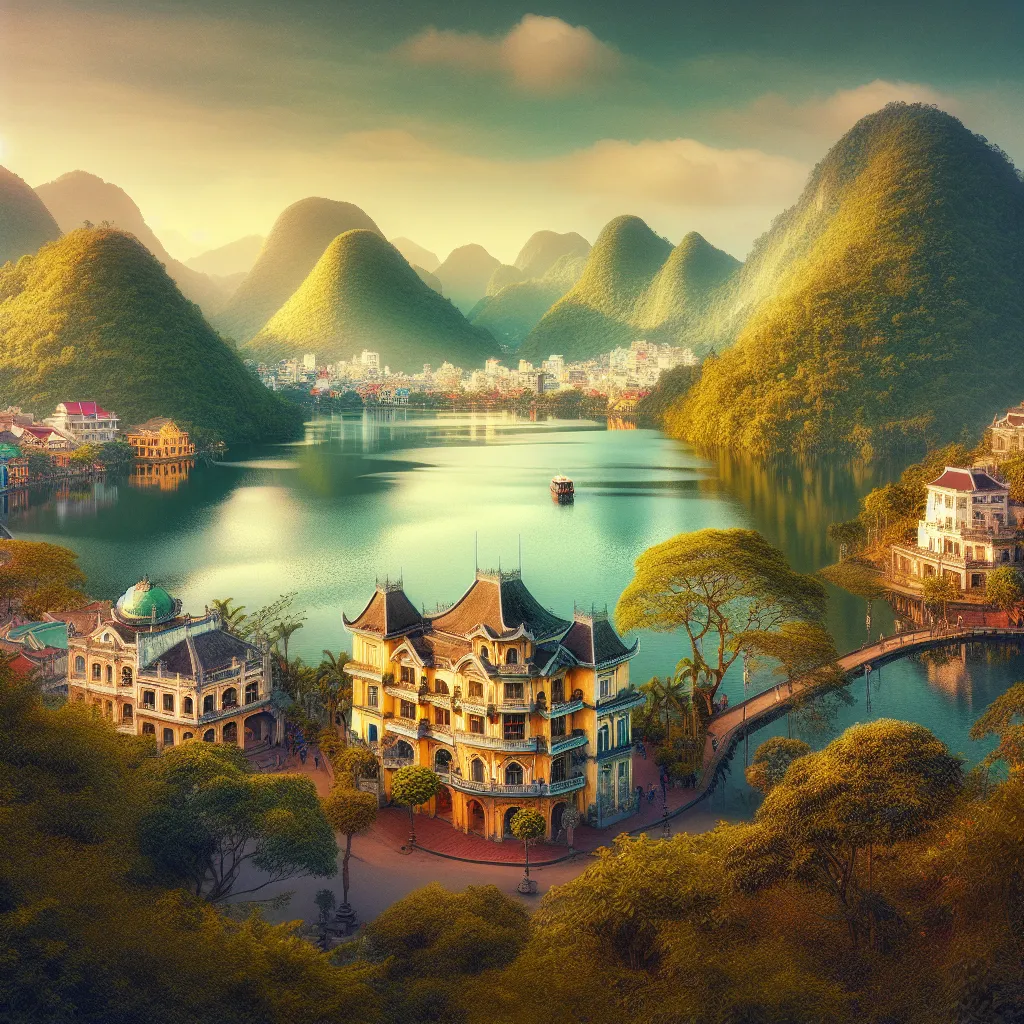The IELTS Speaking test often includes questions about places you like to visit in your country. This topic is a popular choice for examiners as it allows candidates to showcase their language skills while discussing familiar subjects. In this guide, we’ll explore how to effectively answer questions about describing a part of your country you enjoy visiting, with sample answers for different band scores.
Part 1: Introduction and Interview
In this section, the examiner may ask you some general questions about places you like to visit. Here are some common questions you might encounter:
- Do you enjoy traveling within your country?
- What’s your favorite place to visit in your country?
- How often do you travel to different parts of your country?
- Do you prefer visiting cities or natural areas in your country?
Let’s look at a sample answer for the second question:
Question: What’s your favorite place to visit in your country?
Band 6-7 Answer:
“My favorite place to visit in my country is Da Lat. It’s a beautiful city in the Central Highlands of Vietnam. I love it because of its cool climate and lovely scenery. There are many interesting attractions like flower gardens and waterfalls.”
Band 8-9 Answer:
“I’d have to say that my favorite destination within Vietnam is the picturesque city of Da Lat. Nestled in the Central Highlands, it’s renowned for its temperate climate, which provides a welcome respite from the tropical heat of other regions. What truly captivates me about Da Lat is its stunning natural beauty, characterized by lush pine forests, cascading waterfalls, and vibrant flower gardens. The city’s French colonial architecture adds a unique charm, making it a perfect blend of natural and cultural attractions.”
Part 2: Long Turn (Cue Card)
In this section, you’ll be given a cue card with a topic to speak about for 1-2 minutes. Here’s a sample cue card related to our theme:
Describe a part of your country that you enjoy visiting
You should say:
- Where it is
- What you can see and do there
- Why you enjoy visiting this place
- And explain why you would recommend this place to others
Band 6-7 Answer:
“I’d like to talk about Ha Long Bay, which is a beautiful place in the north of Vietnam. It’s famous for its thousands of limestone islands rising from the sea. When you visit Ha Long Bay, you can see amazing rock formations and caves. There are many activities to do there, like kayaking, swimming, and taking boat tours.
I enjoy visiting Ha Long Bay because it’s so peaceful and relaxing. The scenery is breathtaking, especially at sunset. It’s also interesting to learn about the local fishing communities who live on floating villages.
I would recommend this place to others because it’s a unique natural wonder. It’s not just beautiful, but also has cultural significance for Vietnam. Visitors can experience both nature and tradition in one place. It’s really a must-see destination for anyone coming to Vietnam.”
Band 8-9 Answer:
“I’d like to discuss Ha Long Bay, a UNESCO World Heritage Site located in the Gulf of Tonkin in northern Vietnam. This breathtaking seascape is renowned for its emerald waters and thousands of towering limestone karsts and islets of various shapes and sizes.
Visitors to Ha Long Bay are treated to a visual feast of natural wonders. The bay’s iconic landscape features a myriad of oddly shaped islands, many of which house vast, otherworldly caves adorned with stalactites and stalagmites. Activities abound, from serene kayaking expeditions through hidden lagoons to exhilarating rock climbing on cat ba island. One can also immerse oneself in local culture by visiting the floating fishing villages that have existed for generations.
What I find particularly captivating about Ha Long Bay is its ability to evoke a sense of timelessness. The ethereal mist that often shrouds the islands in the early morning creates an almost mystical atmosphere, making it easy to imagine that you’ve stepped back into a prehistoric era. The bay’s ever-changing light throughout the day offers endless photographic opportunities, with each hour presenting a new perspective on this natural masterpiece.
I wholeheartedly recommend Ha Long Bay to others for several compelling reasons. Firstly, it offers a unique convergence of geological, ecological, and cultural significance. The bay’s biodiversity is remarkable, with numerous endemic species of flora and fauna. Furthermore, the area’s rich history, dating back to prehistoric times, adds layers of intrigue for history enthusiasts. Lastly, the sustainable tourism initiatives being implemented in the region ensure that visitors can enjoy this natural wonder while supporting its preservation for future generations. In essence, Ha Long Bay provides an unparalleled, multifaceted experience that leaves an indelible impression on all who visit.”

Follow-up Questions
- How has tourism affected this area?
- Do you think the government should limit the number of tourists visiting popular natural sites like this?
Band 6-7 Answer for Question 1:
“Tourism has had both positive and negative effects on Ha Long Bay. On the positive side, it has brought economic benefits to the local community and helped to promote Vietnamese culture. However, there are also some negative impacts, such as increased pollution and damage to the natural environment. The government is trying to balance tourism and conservation, but it’s a challenging task.”
Band 8-9 Answer for Question 1:
“The impact of tourism on Ha Long Bay has been multifaceted and profound. On one hand, it has been a significant economic driver for the region, creating employment opportunities and stimulating infrastructure development. The influx of visitors has also put Vietnam on the global tourism map, fostering cultural exchange and enhancing the country’s international profile.
However, the exponential growth in tourism has also posed considerable challenges. The bay has experienced environmental stress, including water pollution from boats and litter left by tourists. The delicate ecosystem of the area, including its coral reefs and marine life, has been under threat. Moreover, there’s been a strain on local resources and concerns about the authenticity of cultural experiences being diluted for mass tourism.
In response, there’s been a concerted effort to implement sustainable tourism practices. This includes the introduction of eco-friendly boats, stricter waste management policies, and initiatives to educate tourists about the bay’s ecological importance. While these measures are steps in the right direction, striking the perfect balance between tourism development and environmental preservation remains an ongoing challenge that requires continuous attention and innovation.”
Part 3: Two-way Discussion
In this section, the examiner will ask you more abstract questions related to the topic. Here’s an example:
Question: How can countries balance tourism development with environmental protection in popular natural sites?
Band 6-7 Answer:
“Balancing tourism and environmental protection is challenging but important. Countries can do this by setting limits on the number of visitors, charging entrance fees to fund conservation efforts, and educating tourists about protecting the environment. They should also invest in eco-friendly infrastructure and support local communities to benefit from tourism without harming nature. It’s important to find a balance between economic benefits and preserving natural beauty for the future.”
Band 8-9 Answer:
“Striking a balance between tourism development and environmental protection in popular natural sites is a complex and multifaceted challenge that requires a holistic and nuanced approach.
Firstly, implementing sustainable tourism practices is crucial. This can involve setting scientifically determined carrying capacities for sites and using advanced booking systems to manage visitor numbers effectively. Differential pricing strategies can also be employed, with higher fees during peak seasons to discourage overcrowding and generate funds for conservation efforts.
Secondly, investing in eco-friendly infrastructure is paramount. This includes developing green transportation options, such as electric shuttles or well-planned hiking trails, and constructing facilities using sustainable materials and designs that blend with the natural environment.
Education plays a vital role as well. Comprehensive visitor education programs can foster a sense of environmental stewardship among tourists. This could involve interactive exhibits, guided nature walks, and clear signage about the ecological importance of the site and proper behavior.
Furthermore, engaging local communities in tourism management is essential. By empowering local residents to become stakeholders in conservation efforts and beneficiaries of tourism revenue, countries can create a vested interest in preserving natural sites while ensuring economic benefits are distributed equitably.
Lastly, embracing technological innovations can aid in both conservation and tourism management. For instance, using drones for monitoring wildlife and employing AI for predictive modeling of environmental impacts can inform more effective protection strategies.
In conclusion, successful balance requires a dynamic and adaptive approach, continually reassessing and adjusting strategies based on scientific data, environmental indicators, and stakeholder feedback. It’s about creating a symbiotic relationship where tourism becomes a tool for conservation rather than a threat to it.”
Key Vocabulary and Phrases for High Scores
-
Picturesque (adjective) /ˌpɪk.tʃəˈresk/ – visually attractive, especially in a quaint or charming way
Example: The picturesque village nestled in the valley attracted many tourists. -
Biodiversity (noun) /ˌbaɪ.əʊ.daɪˈvɜː.sə.ti/ – the variety of plant and animal life in a particular habitat
Example: The rainforest’s rich biodiversity is crucial for the planet’s ecosystem. -
Sustainable tourism (noun phrase) /səˈsteɪ.nə.bəl ˈtʊə.rɪ.zəm/ – tourism that respects both local people and the traveler, cultural heritage and the environment
Example: The country is promoting sustainable tourism to protect its natural resources. -
Cultural significance (noun phrase) /ˈkʌl.tʃər.əl sɪɡˈnɪf.ɪ.kəns/ – importance in terms of a culture or civilization
Example: The ancient temple holds great cultural significance for the local community. -
Ethereal (adjective) /ɪˈθɪə.ri.əl/ – extremely delicate and light in a way that seems not to be of this world
Example: The mist gave the landscape an ethereal quality at dawn.
Examiner’s Advice
To score high in the IELTS Speaking test when describing a part of your country you enjoy visiting:
- Use a wide range of vocabulary, including less common words and phrases related to travel and nature.
- Demonstrate your ability to use complex grammatical structures accurately.
- Speak fluently and coherently, organizing your ideas logically.
- Provide detailed descriptions and explanations, going beyond surface-level observations.
- Show your ability to discuss abstract ideas, especially in Part 3.
- Practice describing different locations in your country to build confidence and fluency.
Remember, the key to success is not just about memorizing answers, but about developing the ability to communicate effectively on a range of topics related to places you enjoy visiting in your country.
For more tips on improving your IELTS Speaking skills, check out our guide on how to describe a place you visited that left a lasting impression on you.
